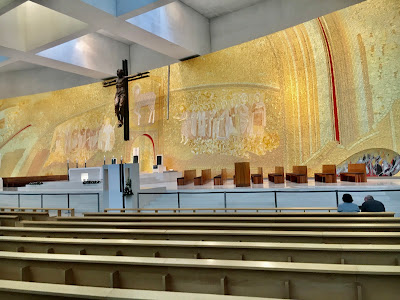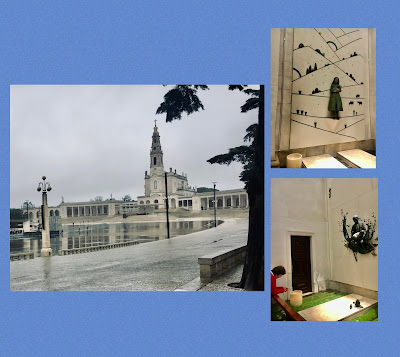At the start of our Marian Pilgrimage, I felt overwhelmed. When I first heard about the trip, I didn’t
think my joining was possible. But see, God works miracles. He answers prayers
– I set foot on Portugal.
Our first stop was Lisbon. After lunch, we were taken on a guided walking tour to Alfama, a historic part of the city and one of Lisbon’s oldest areas with steep streets lined with shops selling traditional crafts and cafes.
Located in this area is the church
dedicated to my favorite saint, the Igreja de Santo António de
Lisboa. It is built on the site where he
was born and classified as a National Monument. St. Anthony is the
patron saint of Lisbon, lovers and lost things. I misplace things a lot so guess who is the saint that
I always pester about these memory lapses.
Unfortunately, our time in Lisbon
was limited but we did get a glimpse (just a glimpse) of the Lisbon Cathedral,
the oldest church in the city, the Campo das Cebolas (Onion
Field), one of the most historical and beloved areas of Lisbon,
the Casa
dos Bicos (House of Beaks/Spikes), a 16th century palace that is an
architectural curiosity with a façade of 1,125 spikes,
Casa dos Bicos (middle building)
and the Jerónimos Monastery
(Mosteiro dos Jerónimos), a former monastery of the Order of St. Jerome. It is
a UNESCO World Heritage Site and the final resting place of Vasco Da Gama.
After Lisbon, we were off to one of the main destinations
of our pilgrimage, Fatima. The
Sanctuary of Our Lady of Fatima (Santuário de
Fátima) is a memorial
for one of the few apparitions officially recognized by the Catholic Church. It
is a huge complex made up of basilicas and chapels situated in Cova da Iria
where the Virgin Mary appeared to Lúcia dos Santos and her cousins, Francisco
and Jacinta Marto in 1917. It is the 4th biggest Catholic pilgrimage
site in the world. It was here that the Blessed Mother reminded us to pray to
her Son so that souls may be saved and not be lost to evil.
The next day, our tour guide showed us the Basilica of the Most Holy Trinity (Basílica da Santíssima Trindade), the 4th biggest Catholic church in the world with a seating capacity of 8,633,

Altar of the Basilica of the Most Holy Trinity
the Basilica of Our Lady of the Rosary (Basílica de Nossa Senhora do
Rosário) where Francisco, Jacinta and Lúcia are buried,
and the houses of the 3 shepherd children as well as the sites
of the 2nd and 3rd apparitions in Aljustrel.
One of things that piqued my interest during our tour was the Berlin Wall Monument (Muro de Berlim), a segment of the Berlin Wall symbolizing the belief that the rosary
prayers influenced its fall in relation to the second Secret of Fatima.
Back in the Sanctuary, we viewed the Fátima Luz e Paz (Fatima Light and Peace), a permanent exhibit at the Rectory Building featuring the golden crown
of Mary with the bullet that almost killed Pope John Paul II incorporated in
its center.
We were lucky that Hotel Fatima, where we were billeted, was right beside the sanctuary. We were able to join the multilingual rosary in the evening.
It was held at the Chapel of the Apparitions (Capelinha das Aparicões). The chapel is built on the exact spot where the oak tree was rooted, next to which
the Virgin Mary appeared. It houses the original statue (c.1920) of the Virgin Mary. This is the Heart of the Sanctuary.
Reflection: I thought sacrifice was only about suffering, doing things you don’t like, going through difficult situations. Through the visionaries of Fatima, I learned that sacrifice is “to make holy” the things that you do for others.










No comments:
Post a Comment